Those who had freedom, equality and fraternity on their banners, sent the so-called hell columns that drowned the province in a sea of blood and fire. Those events are sometimes called the first genocide in modern history of Europe. And there is no exaggeration in that.
It is certainly one of the most embarrassing pages in French history. At the end of January 1794, the French republican army began to drown in blood those who, in the name of God, would oppose the followers of Reason. We are talking about the inhabitants of the province of Vendee in the northwest of the country - mainly illiterate peasants. Although the Revolution acted for the liberation of the people, it was the simple people who rebelled against the ever stronger dictatorship and revolutionary terror. And he paid a terrible price.
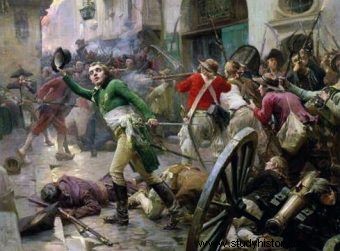
The Wandejskie Wars are sometimes called the first genocide in the history of modern Europe
As the eminent historian Paweł Jasienica accurately described it in his essay "Meditations on the Civil War", the Wandejskie Uprising is a great paradox. Those who went into battle fought against those who claimed to be their defenders. "This book talked about those who, by loving their visions too much, betrayed the reform agenda, and those who were stigmatized as backers and criminals, were actually faithful to it" - wrote in the last word of his work.
In the name of God and the king
An anti-republican uprising broke out in one of the poorest parts of the country, and it was driven by those who lived the lowest in the social hierarchy, i.e. the peasants. Theoretically, they should have supported the Revolution to the greatest extent, because the king was deposed in defense of the people. And yet - although in the first period the Vandejans actually favored the revolutionary authorities, and the ancien régime treated with distance - with time the doctrine, madness and dictatorial inclinations of the revolutionaries began to arouse more and more resistance among simple people who were attached to traditional values and simply wanted a just and honest life, as well as respect for the values they believed in. It was this blow to the realm of values that pushed the farmers of the Vendée to put their scythe upside down and to make wars with the republic under the slogan "God and King".
The immediate cause of the revolt was compulsory military call-ups for thousands of provincial men, often the only breadwinners who had to abandon their farms to join the army. The anger, however, grew gradually earlier, along with the increasingly severe harassment of the republic against the Catholic Church, hated by revolutionaries.
There was no room for belief in God in a revolutionary world. Enlightened Republicans, like their mentors - Voltaire and Rosseau, believed in Reason. It was only after drowning the Vendée in blood that Maximilian de Robespierre realized that the people had not forgotten God. Therefore, real faith had to be changed into a counterfeit. The existence of the Supreme Being was sanctioned by the decree of the National Convention. As part of the ceremonies created from above, the cult of the "essence" was performed personally by Robespierre. He led all sorts of grotesque parades and processions to glorify the secular "God".
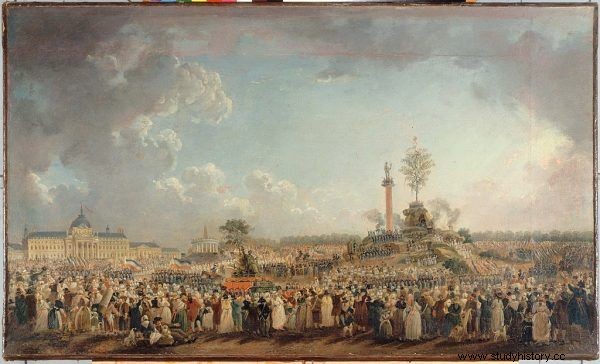
Religious celebrations related to the cult of the Supreme Being
In 1790, the civil constitution of the clergy was passed, forcing priests to swear allegiance to the republic. Then the church property was confiscated. Disobedient clergy were harassed and lost parishes. Murders happened more and more. In the same year, the Revolution hit the monasteries. Thousands of nuns and religious lost their lives. Thousands more fled the country to French Guiana.
With the Reign of Terror, the Paris Commune banned services, and churches were closed. Death sentences were carried out on clergy, sometimes in a terrifying way. Self-judgments multiplied. During the so-called the September massacres in 1792, an enraged crowd, accusing the nobility and priests who had not sworn by the constitution of treason and collaboration with the Prussians, attacked a convoy carrying representatives of the clergy. This was the beginning of the crime wave. The mob raided prisons and arrests, murdering the clergy and high-born held there with primitive bladed weapons and torture. There have been cases of pile-driving.
"Carry out the extermination to the last man"
The events in the capital aroused more and more dread in a remote, deeply Catholic province. Although the Vendee was not originally anti-revolutionary, the attack on the Church changed the mood. Also because, along with the liquidated parishes, the peasants not only lost their clergy, but also basic health care and schools for children - all these institutions operated within the parish. The people of the Vendée more and more often stood up in defense of the clergy and were bloodily punished for it. In August 1792, in the town of Breissure, the National Guard murdered nearly five hundred unarmed parishioners who opposed the eviction of nuns from a nearby convent.
The spark that finally started the insurgent fire was regicide. After the revolutionary authorities guillotined the deposed Louis XVI on January 21, 1793, and then summoned thousands of people to the army, the peasants of the Vendée, led by the royalist nobility and the military (including the general of the uprising, François de Charette), set scythes upright and attacked republicans and their atheistic orders.
Thus, one province stood against forces from all over a great country. The mission was lethal. Despite this, the uprising in the initial period was spectacularly successful. Wandejscy peasants, who knew their area very well, quickly gained an advantage. They turned out to be great, brave soldiers, successfully facing the best regular republican troops. The Great Catholic and Royal Army went into battle with the scapular, the symbol of the heart and cross and the inscription "God and King". At the end of June 1793, she captured Nantes.
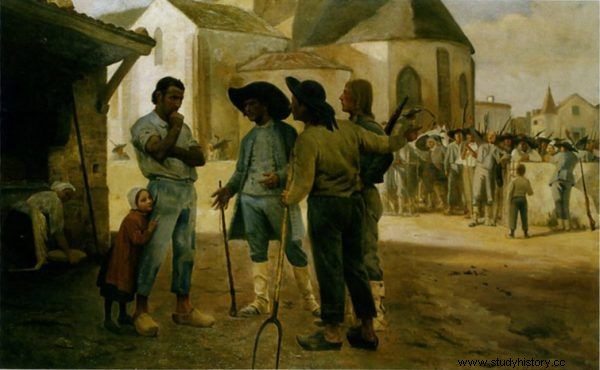
The insurgents urge Cathelineau to take the lead
Over time, however, the Republicans began to regain the field, mainly because the peasants who were "at home" returned to their homes and farms after each victorious campaign, so the mass mobilization had to gather over and over again. The insurgents' faith in the help of England was also of no avail. Although revolutionary France was hated with all their hearts on the islands, support for the insurgents did not arrive, and it was not possible to gain footholds on the coast, but the terror of the republican troops intensified. One of the Convention's decrees read:
The Minister of War will send all kinds of combustibles to the Vendee to destroy trees and brush. Forests will be cut down, rebel shelters demolished, crops mowed and taken to the back of a functioning army, domestic cattle will be confiscated. The rebels' property will become the property of the Republic. Women, children and the elderly will be transported deep into the country, where they will be maintained and safe by respecting the principles of humanity.
However, there were other orders as well, ordering the outright murder of the hated fighters ancien régime , backward and religious - because that was the only way they were perceived in the capital. The convention ordered "to carry out the extermination to the last man", "to extinguish like lice".
The columns of hell
At the end of 1793, the situation of the Wandejska army was deplorable. On December 12, 1793, the republic's troops recaptured from the hands of the insurgents of Le Mans. The battle turned into the slaughter of thousands of people. Several thousand people died under the republican bayonets - including women and children.
The final defeat of the insurgent army was the Battle of Savenay, just before Christmas Eve 1793. Three times more numerous forces of the republic led by Generals Jean-Baptiste Kléber and François Séverin Marceau - after bloody fighting in the city, they again committed massacres. The death sentences were carried out on all prisoners and residents who had even a shadow of suspicion of collaboration with the royalists. Up to 2,000 people died. General François Joseph Westermann reported enthusiastically:
The Vendée is gone, Republican citizens. Together with her women and children, she died under our free saber. I bury her in the swamps and forests of Savenay. In accordance with the orders you gave me, I crushed children with horse hooves, massacred women who - at least these women - would no longer bear bandits.
I don't have a single prisoner on my conscience. I exterminated everyone ... My hussars have scraps of bandit banners on their ponytails. The roads are littered with dead bodies. There are so many of them that they form pyramids in many places. He shoots himself all the time in Savenay, because there are bandits constantly coming and wanting to surrender ... We don't take prisoners; they would have to be given the bread of freedom, and pity is not a revolution.
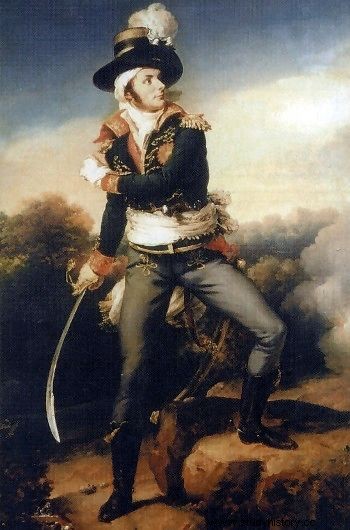
François de Charette - leader of the Vendee revolt
Westermann exaggerated by announcing the end of the uprising as early as December 1793. The royalist, Catholic Vendee fought for three more years, mainly in partisans. The remnants survived in the forests until 1800, but at the turn of 1793 and 1794, after the first wave of terror, the worst was yet to come.
In January 1794, a revolutionary decree came into force ordering the "destruction of the Vendee". A new republican force, led by General Lousia Marie Turreau, arrived in the province. The 12 army columns were called hell columns and it was not a coincidence . The general's order left no room for doubt:“Bear everyone on bayonet blades. Villages, farms, forests, groves, anything that can burn will be released to the flames. ".
The march of revolutionary troops through the province turned into genocide. The soldiers raped the bodies of living and dead women, killed old people and children in homes and hospitals. Cannons were fired at churches where people were sheltering. This is how more than 500 women and children from Lucs-sur-Bologne died. The youngest victim - a newborn - lived less than two weeks. "The day was tiring but fruitful," commented the commander of the Republican army, General Cordelier. Jasienica commented:
1,200 people were slaughtered in the Vezins forest, where the survivor's hospital camp was located. Women were raped on piles of roadside stones and on church altars, babies were carried on bayonets . In order to save gunpowder, butts and other weapons, they were burned alive .
On scaffolds and monuments
As part of a revolutionary act, the authors of the slaughter and its performers came up with a valuable "innovation" that helps to cleanse the Wandejskie land even more zealously from "enemies of the people". As stated - the guillotine works too slowly. Therefore, Turreau and his men began to drown their victims in the Loire River at Nantes. The so-called melting, or n oyady (from the French noyer , or "to melt"). Convicts, often strangers to each other, were tied in twos and thrown into the river. This form of murder was derisively called "republican marriages."
There was also a way to "wholesale" death. For this purpose, the convicts were led onto a specially prepared ship. All exits were barred and sealed. Then the ship went down. Up to several hundred people died in one blow in a terrible drowned death. Jean Baptiste Carrirer, the Convention's envoy to the rebellious Vendee, reported enthusiastically: " Last night, 53 priests locked on a barge were drowned in the river. What a revolutionary river from this Loire! ”. Revolutionary reports show that 23 noyads were organized within a few months. Up to 10,000 people were murdered in total.
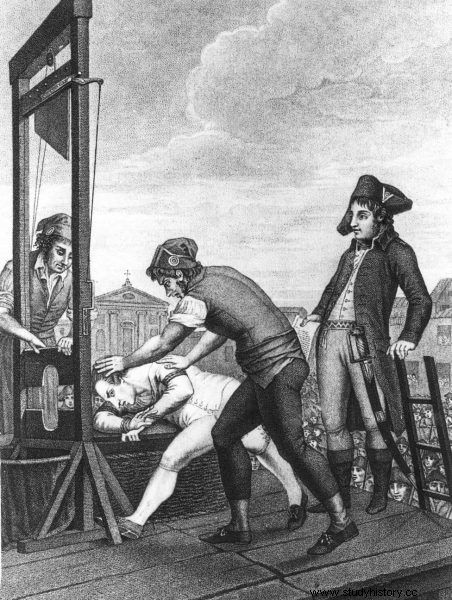
Robespierre put his head on the guillotine
Today it is estimated that the slaughter of the Vendée claimed up to 600,000 victims, although most researchers agree that the figure is 300,000. The history of the royalist uprising is sometimes called the first genocide in modern Europe. Interestingly, in the same year 1794, after the fall of the Jacobin dictatorship, the main principals and perpetrators of the Vendee slaughter came to the scaffold. The sentence of Maximilian de Robespierre was carried out on July 28 after the Thermidorian coup. Earlier - accused of supporting Danton, he surrendered his head to General Westermann, and Carrirer was guillotined on December 16.
However, there were also those who, despite blood on their hands, spent a long time basking in the honor and served France - no matter from which side they managed. General Turreau - the commander of the hell columns - not only did not lay his head down, but was even rehabilitated. After overthrowing the Jacobins, revolutionary France found that he was merely following orders. Later, Turreau successfully served under Napoleon, but when the emperor had a bad leg, it turned out that, just like the Vendéans, whom he was murdering, at heart he was ... a royalist. When the Bourbons regained power in 1814, the general freely entered the service of King Louis XVIII. To this day, his name appears on the Arc de Triomphe in the heart of the French capital, alongside other distinguished ...
And the wandejscy peasants? The sacrifice they suffered remained in the shadow of the history of the Revolution for a long time. And nowadays it is not talked about too loudly, especially when the real evaluation of the achievements of those who unleashed hell in France in the name of freedom, equality and fraternity is dominated by mythology, fantasies and current political sympathies.
As Paweł Jasienica wrote - it was the deeply religious Catholic peasants of Wandejski who were the embodiment of revolutionary ideals and they fought for them, regardless of their state, origin, worldview and religion. The disrespect and stubborn doctrine of revolutionary dictatorship pushed these peaceful and not at all royalist people to fight for the right to exist in the world in which they grew up and believed in.
